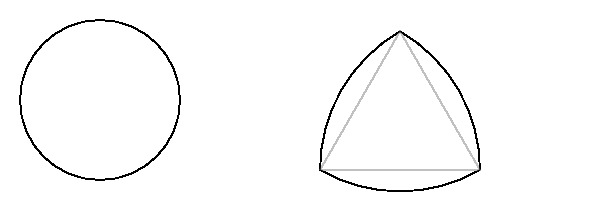such that the distance of the two parallel lines which catch
does not depend the slope.
Circles and Rulos triangles are typical examples of curves of constant width

Theorem 1
If we catch C by two parallel lines,
then each line contacts with C at one point
and the line connecting the two contact points is orthogonal to the two lines.
The curve of constant width whose upper half is expressed by
Theorem 2
x = (cos θ)h(θ) - (sin θ)h'(θ), y = (sin θ)h(θ) + (cos θ)h'(θ)
is of constant width.
(i) h(θ) + h(θ + π) = d
(ii) h(θ) is C3 class except at finite points.
(iii) 0 ≦ h(θ) + h''(θ) ≦ d
If h(θ) = r + a cos θ + b sin θ on an interval,
then a part of the curve in the above theorem is a circular arc with a radius of r and the center (a, b).
Type I :
Then the blue curve go around once in the above square box.
Type II : 1. < b = < √2, t0 = π / b.
h(θ) = 1 + cos(bθ) for 0 < θ < t0
h(θ) = 0 for t0 < θ < π
Type III :
h(θ) = 4(θ - π / 2)2 / π2 for 0 < θ < π
Type IV : tan t0 = 0.75.
h(θ) = 1.75 - cos(θ) for 0 < θ < t0
h(θ) = 0.5 + 0.75 * sin(θ) for t0 < θ < π/2
h(θ) = 1.25 for π/2 < θ < π
Type V : (
h(θ) = 1 + 1.2 (θ - π/2) sin(1.5 c) for c < θ < π - c
h(θ) = 1 + 0.8 cos(1.5 (θ - π)) for π - c < θ < π